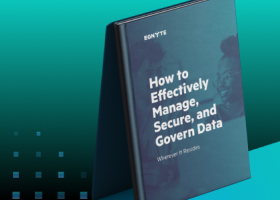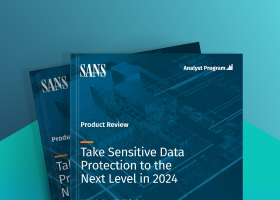Securing Your Multi-Cloud Infrastructure: Strategies and Best Practices
Multi-cloud infrastructure utilizes a consistent set of tools across different cloud environments. It can include a mix of public and private clouds, and on-premises IT infrastructure. A multi-cloud approach empowers organizations to select the most suitable cloud services for specific workloads, optimize performance, and avoid vendor lock-in. By diversifying cloud providers and services, businesses can enhance resilience, reduce downtime, and achieve greater agility in managing their IT environments, as well as save on upfront IT infrastructure expenses.

Companies must ensure data confidentiality, integrity, and availability in such setups to protect against cyber threats, data breaches, and compliance violations. Robust security measures safeguard sensitive information and build trust with customers, partners, and regulatory bodies, reinforcing the reliability and credibility of the organization’s cloud infrastructure.
As organizations navigate the complexities of securing their cloud infrastructure, understanding the significance of security in these environments and addressing key security concerns are essential steps towards building a robust and resilient cloud ecosystem. Let’s explore strategies and best practices to help organizations secure their cloud infrastructure effectively, mitigate security risks, and optimize the performance and reliability of their cloud operations.
Significance of Security in Multi-Cloud Environments
Security in multi-cloud infrastructure is critical due to the complex nature of managing data and applications across multiple cloud platforms. As organizations increasingly adopt multi-cloud strategies, they face unique security challenges that require robust solutions to safeguard their assets and maintain compliance.
The Need for Security
Data Protection
With data dispersed across various cloud environments, organizations must ensure its confidentiality, integrity, and availability to prevent unauthorized access or data breaches.
Compliance Requirements
Different cloud providers have varying compliance standards and regulations. Maintaining compliance across multiple cloud platforms necessitates a comprehensive security strategy to meet regulatory requirements.
Risk Mitigation
While using multiple clouds, companies introduce additional points of vulnerability, increasing the risk of cyber threats. Proactive security measures are essential to mitigate these risks and protect sensitive information.
Business Continuity
Security breaches or data loss in one cloud provider can impact the entire environment. Implementing robust security measures ensures business continuity and minimizes disruptions.
Understanding Security Concerns in Multi-Cloud Infrastructure
Multiple cloud environments offer organizations flexibility, scalability, and redundancy in IT operations. However, these benefits come with inherent security concerns that require remedial measures to safeguard data, protect against cyber threats, and ensure compliance. Let’s delve into the security challenges faced in these environments.
Overview of Sprawling Multiple Cloud Infrastructure
Sprawling multi-cloud environments decentralize workloads, applications and data across multiple cloud platforms and services. As organizations embrace diverse cloud environments to meet specific business needs, the complexity of managing and securing these distributed resources increases. Sprawling cloud infrastructure can lead to challenges in visibility, control, and governance, making it crucial for organizations to implement robust security measures to mitigate risks and maintain a secure cloud environment.
Identifying Common Security Risks
Data Breaches
Data breaches pose a significant threat in diverse cloud environments as sensitive information traverses multiple cloud platforms and networks. Weak access controls, misconfigurations, and vulnerabilities in cloud services can expose data to unauthorized access, leading to breaches that compromise confidentiality and integrity. Implementing end-to-end encryption, access controls, and monitoring tools are essential to protect data and prevent unauthorized access.
Compliance Challenges
Compliance challenges arise in diverse cloud environments due to the complexity of regulatory requirements across different cloud providers and regions. Ensuring data sovereignty, privacy, and compliance with industry regulations such as GDPR, HIPAA, or PCI-DSS can be daunting in a diverse cloud setup. Organizations must implement robust governance frameworks, audit trails, and compliance monitoring to meet regulatory obligations and avoid penalties.
Identity and Access Management (IAM) Issues
IAM issues can arise in diverse cloud environments, where managing user identities, permissions, and access controls across disparate cloud platforms becomes challenging. Inadequate practices, weak authentication mechanisms, and improper user provisioning can lead to unauthorized access, insider threats, and data breaches. Implementing centralized IAM solutions, multi-factor authentication, and least privilege access principles are critical to enhancing security and reducing risks.
Data Loss Prevention
Multi-cloud infrastructure comes with significant data loss prevention concerns since data gets distributed across multiple cloud services and storage locations. Accidental deletion, data corruption, or service outages can result in data loss that impacts business continuity and reputation. Implementing data backup strategies, disaster recovery plans, and encryption mechanisms can help organizations prevent data loss and ensure data availability in multiple cloud environments.
Understanding the complexities of diverse cloud infrastructure and identifying common security risks helps organizations proactively address these concerns. Implementing robust security measures, best practices, and governance frameworks is essential to safeguard data, protect against cyber threats, and ensure compliance in the dynamic landscape of multiple cloud infrastructures.
Addressing Security Concerns of Multi-Cloud Infrastructure
The multi-cloud revolution has transformed IT landscapes, offering businesses access to a combination of the best cloud services. However, the distributed approach adds a layer of complexity to data security. Let’s explore how to tackle the top security concerns and build a robust cloud platform.
Comprehensive Risk Assessment
The foundation of any effective security strategy lies in understanding the vulnerabilities. Conducting a comprehensive risk assessment helps organizations identify potential threats across the cloud infrastructure.
Create an Inventory of Cloud Assets
Companies must catalog all cloud resources deployed across different providers, including servers, storage, databases, and applications.
Understand Security Models
Organizations should familiarize themselves with the shared responsibility model – where cloud providers secure the infrastructure, and they secure the data and applications running on it.
Threat Modeling
Companies should identify potential attack vectors like misconfigurations, unauthorized access, malware, and data breaches.
Vulnerability Scanning
Organizations should regularly scan cloud resources for known vulnerabilities in software, configurations, and APIs.
Business Impact Analysis
Finally, companies must evaluate the potential impact of security incidents on their finances, reputation, and operations.
While assessing risks, companies can prioritize based on likelihood and impact. It’s a good idea to focus on mitigating high-impact, high-likelihood threats first.
Implementing Robust IAM
Implementing Robust IAM
IAM is the cornerstone of multi-cloud security.
Role-Based Access Control (RBAC)
Implementing RBAC grants users access to cloud resources based on their job roles and responsibilities. The least privilege principle ensures users get access to data they absolutely need.
Multi-Factor Authentication (MFA)
MFA adds an extra layer of security by requiring a second verification factor beyond a password to access cloud resources. It significantly reduces the risk of unauthorized access to an organization’s multi-cloud infrastructure, even if an attacker steals a user’s login credentials.
Privileged Access Management (PAM)
Companies can focus on securing privileged accounts with elevated access to critical systems and data. Implementing PAM solutions help control, monitor, and audit privileged user activities.
Organizations can strengthen their IAM by enforcing strong password policies and regularly rotating user credentials.
Encryption and Data Protection Measures
Data Encryption
Industry-standard encryption algorithms can encrypt data at rest (stored in cloud storage) and in transit, preventing hackers and others from accessing and reading sensitive information.
Key Management Strategies
Practices like key rotation and secure key storage enhance data security and ensure the integrity of encryption keys. Organizations can use a Hardware Security Model (HSM) for additional key protection. These strategies allow companies to securely generate, store, rotate, and revoke encryption keys, ensuring that only authorized users can access encrypted data and preventing unauthorized decryption.
Secure Data Backup and Recovery Solutions
Implementing secure backup and recovery solutions helps organizations recover data due to data loss or security incidents. Regularly backing up critical data and testing recovery procedures ensures a swift and efficient response after a cyberattack or outage. These practices ensure business continuity while working with a diverse cloud environment.
Continuous Monitoring and Incident Response
Proactive monitoring is crucial for early detection and swift response to security incidents.
Security Information and Event Management (SIEM)
Utilizing SIEM tools enables organizations to monitor and analyze security events across multiple cloud platforms, facilitating early detection of security incidents.
Threat Intelligence Integration
Integrating threat intelligence feeds helps organizations stay informed about emerging threats and vulnerabilities. These feeds empower companies to respond to security incidents in multi-cloud environments proactively.
Incident Response Planning and Execution
Developing and testing incident response plans ensures a coordinated and effective response to security breaches, minimizing the impact of incidents on multi-cloud infrastructure.
Regularly conducting incident response drills ensures the organization is prepared to handle a real-world security event effectively.
Cloud Security Automation
Automated cloud processes empower organizations to handle threat detection, vulnerability management, and incident response.
Implementing DevSecOps Practices
Integrating security into the DevOps pipeline promotes a secure culture. It enables organizations to automate security testing and compliance checks in multi-cloud environments. Organizations can identify and remediate security vulnerabilities early, reduce risks, and accelerate deployment by automating security testing, code analysis, and compliance checks.
Leveraging Security Orchestration and Automation
Security orchestration and automation tools streamline security operations by automating repetitive tasks, orchestrating incident response workflows, and integrating security tools for seamless threat detection and response. Organizations can improve efficiency, reduce manual errors, and enhance incident response capabilities with automation.
Compliance Automation Tools
Compliance automation tools help organizations streamline regulatory compliance efforts. Organizations can ensure adherence to industry regulations, standards, and data protection laws by automating policy enforcement, audit trails, and reporting requirements. These practices reduce compliance risks and simplify compliance management.
Enhancing Security in Multi-Cloud Environments
Securing diverse cloud environments requires the strategic integration of unified security strategies, employee training, partnerships with security providers, and regular audits to mitigate risks and protect data across multiple cloud platforms. By implementing best practices in security management, organizations can enhance the resilience and integrity of their cloud infrastructure, ensuring a robust defense against cyber threats and compliance with industry regulations.
Implementing a Unified Security Strategy
An organization’s diverse cloud environment serves as a unified entity to boost security.
Consistent Security Policies Across Cloud Providers
Companies must develop a comprehensive security policy that outlines its security posture and applies consistently across all cloud providers. The policy should address data security, access control, incident response, and vulnerability management. Establishing a consistent security policy across multi-cloud infrastructure ensures uniform protection of assets and data, simplifying security management and reducing vulnerabilities.
Integration of Security Controls
Organizations should never let security controls operate in silos. Integrating security controls, such as firewalls, intrusion detection systems, and encryption mechanisms across different cloud platforms, enhances visibility and control. It enables organizations to monitor and secure their diverse cloud environments effectively.
Training and Awareness Programs
Organizations must focus on empowering employees, as even the most sophisticated tools cannot compensate for human error.
Educating Employees on Security Best Practices
Providing security awareness training to employees helps cultivate a security-conscious culture within the organization. Educating employees about cybersecurity best practices, including password hygiene, phishing email identification, and reporting suspicious activity, empowers staff to recognize and respond to threats quickly.
Conducting Regular Security Training Sessions
Regular security training sessions educate employees about evolving security risks and best practices, equipping them with the knowledge and skills to contribute to a secure multi-cloud environment.
Partnering with Reliable Security Providers
Managing security in a diverse cloud environment can be resource-intensive.
Engaging Managed Security Service Providers (MSSP)
Partnering with MSSPs offers organizations access to specialized expertise, threat intelligence, and security monitoring capabilities to enhance security in their diverse cloud environment. By outsourcing security operations to MSSPs, organizations can augment their security capabilities, detect and respond to threats proactively, and leverage industry best practices for security management.
Leveraging Cloud Security Solutions
Leveraging cloud security solutions, such as Cloud Access Security Brokers (CASBs) and cloud-native security tools, helps organizations secure data, applications, and workloads across their multi-cloud infrastructure. Organizations can strengthen security controls, monitor cloud usage, and mitigate risks by deploying cloud security solutions offering visibility, compliance enforcement, and threat protection.
Regular Audits and Compliance Checks
Regular assessments are critical for ensuring security.
Conducting Periodic Security Audits
Conducting periodic security audits and assessments helps organizations evaluate the effectiveness of security controls, identify vulnerabilities, and address gaps in security posture in a multi-cloud environment. Organizations can proactively detect security weaknesses, remediate issues, and improve overall security resilience and compliance through regular audits.
Ensuring Compliance with Industry Standards and Regulations
Ensuring compliance with industry standards and regulations, such as GDPR, HIPAA, or PCI-DSS, is crucial for maintaining data privacy, integrity, and trust in a diverse cloud environment. By aligning security practices with regulatory requirements, organizations can demonstrate compliance, protect sensitive data, and mitigate legal and reputational risks associated with non-compliance.
Embracing best practices in security management and fostering a culture of security awareness is essential for building a resilient and secure diverse cloud infrastructure that meets the evolving challenges of cloud security and data protection.
The multi-cloud landscape is more than a trend - it’s the future of IT infrastructure. Organizations can gain agility, scalability, and access best-in-class services by strategically leveraging multiple cloud providers simultaneously. However, this flexibility comes with the responsibility of securing valuable data and resources across diverse cloud platforms.
Comprehensive risk assessments, robust IAM protocols, encryption, continuous monitoring and cloud automation measures streamline security processes and boost data safety. Implementing best practices like regular security audits and compliance checks empowers organizations to build a security fortress around their multi-cloud infrastructure. Staying vigilant, adapting to emerging threats, and embracing new security technologies ensures your organization thrives in this dynamic and ever-changing environment.
Egnyte has experts ready to answer your questions. For more than a decade, Egnyte has helped more than 17,000+ customers with millions of users worldwide.
Last Updated: 1st May, 2024


